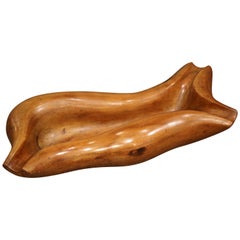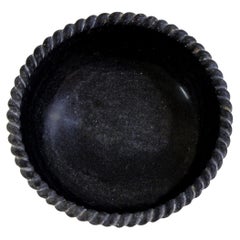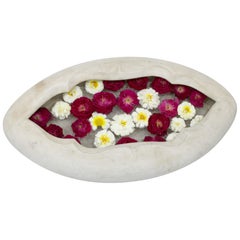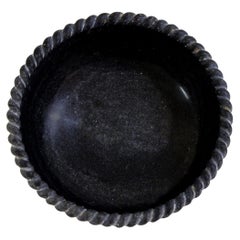Carved Decorative Bowls
to
81
480
196
23
41
182
257
219
53
119
43
2
2
5
9
4
16
24
12
5
3
85
58
55
35
12
12
10
9
5
4
4
2
2
2
1
367
222
114
90
88
328
238
343
151
116
110
104
Height
to
Width
to
699
646
686
22
20
20
12
10
Technique: Carved
Weave Bowl in White Marble Handcrafted in India by Stephanie Odegard
Located in New York, NY
Sculpted out of a single block of marble with a delicately carved, perfect for a potpourri, a fruit bowl or just a key catch.
Weave bowl in white ...
Category
2010s Indian Other Carved Decorative Bowls
Materials
Marble
Midcentury French Carved Walnut Tree Root Centerpiece Bowl Signed Delaporte
Located in Dallas, TX
Decorate a dining table or a coffee table with this elegant hand carved center bowl. Crafted in France circa 1950, the fruit wood dish is rectangular in shape with scalloped edges an...
Category
Mid-20th Century French Carved Decorative Bowls
Materials
Walnut
Rope Bowl in Black Marble Handcrafted in India by Stephanie Odegard
Located in New York, NY
Sculpted out of a single block of marble with a delicately carved rope edge, perfect for a potpourri, a fruit bowl or just a key catch.
Round Rope Bowl in Black Marble
Size- 12” x ...
Category
2010s Indian Other Carved Decorative Bowls
Materials
Marble
Oval Pot in White Marble by Paul Mathieu for Stephanie Odegard
Located in New York, NY
Inspired by the traditional Ajna Chakra motif found depicting the third eye in the ancient Indian Tantric scriptures, this bowl is hand carved from a single block of stone. A perfect...
Category
2010s Indian Other Carved Decorative Bowls
Materials
Marble
Rope Bowl in Black Marble Handcrafted in India by Stephanie Odegard
Located in New York, NY
Sculpted out of a single block of marble with a delicately carved rope edge, perfect for a potpourri, a fruit bowl or just a key catch.
Round Rope Bowl in Black Marble
Size- 10” x ...
Category
2010s Indian Other Carved Decorative Bowls
Materials
Marble
Pink Mould Project by Theodora Alfredsdottir
Located in Geneve, CH
Pink mould project by Theodora Alfredsdottir
Unique
Materials: Jesmonite
Dimensions: 120 x 90 x 35 mm.
Theodora Alfredsdottir is a product design studio based in London.
Theo...
Category
2010s English Modern Carved Decorative Bowls
Materials
Cement
$264 / item
Lily Pad Soap Dish
Located in Chicago, IL
These hand-carved marble soap dishes are crafted by traditional artisans in Rajasthan State, India. Their shape derives from lily pads, and they drain excellently, sparing one's soap from getting soggy.
DESIGNER
Michael W...
Category
21st Century and Contemporary Indian Carved Decorative Bowls
Materials
Marble
Marble Fruit Tray
Located in Chicago, IL
The spines of this fruit tray allow air circulate around fruit, extending its freshness. This tray is hand-carved by traditional stone artisans in Rajasthan...
Category
21st Century and Contemporary Indian Carved Decorative Bowls
Materials
Marble
Large Rock Crystal Oval Bowl
Located in Los Angeles, CA
A large, beautifully carved rock crystal bowl with scalloped edge.
Modern Fabrication.
Category
2010s French Carved Decorative Bowls
Materials
Rock Crystal
Little Table or High Tray from Indonesia
Located in Alessandria, Piemonte
Vintage high tray for fruit, or comfortable little table near an armchair - from Dulang (Indonesia).
Very interesting!
O/2685.
Category
Mid-20th Century Indonesian Other Carved Decorative Bowls
Materials
Fruitwood
19th Century Swedish Folk Art Wooden Funnel
Located in Bozeman, MT
Antique early 19th century folk art wooden funnel carved out of one piece of wood. Ca 1800 Sweden.
Category
Early 19th Century Swedish Folk Art Antique Carved Decorative Bowls
Materials
Pine
Arabescato Marble Marmo Fluido Centrepiece, Tray By DFdesignlab
By DF designlab
Located in Campobasso, CB
Centerpiece in Arabescato vagli marble.
The idea was to make the marble appear flexible and fluid to the eye and to the touch, to give the sensation th...
Category
21st Century and Contemporary Italian Modern Carved Decorative Bowls
Materials
Marble
$1,538 Sale Price
20% Off
Antique Japanese Rustic Burl Bowl
Located in Hudson, NY
Large hand carved, natural shaped bowl. Wonderful burl grain and knot details.
Category
1850s Japanese Antique Carved Decorative Bowls
Materials
Wood
341 Hand Crafted Gathering Stoneware Bowl by Helen Prior
By Helen Prior
Located in New Paltz, NY
341 Hand Crafted Gathering Stoneware Bowl by Helen Prior
A delicate hand-crafted bowl, organic in shape with a torn clay edge in natural speckled stoneware clay.
Part of the Cross P...
Category
21st Century and Contemporary American Modern Carved Decorative Bowls
Materials
Gold
Antique Bohemian White Opaline Centerpiece Resting on a White Opaline Plinth
Located in New York, NY
A rare hand-carved and faceted 19th century antique bohemian white opaline centerpiece resting on its original white opaline plinth. The opaline crystal is of the finest quality with...
Category
1850s Czech Other Antique Carved Decorative Bowls
Materials
Crystal
Large 19th C. Bohemian Amber-cut-to-clear Crystal Punch Bowl W/ Hunting Scenes
Located in New York, NY
A Spectacular and Quite Large 19th Century Bohemian Amber-Cut-to-Clear Crystal Punch Bowl with Hunting Scenes and Underplate. This marvelous three-piece punch bowl is complete with a...
Category
19th Century Czech Louis XVI Antique Carved Decorative Bowls
Materials
Crystal
Hand Painted Flower Mexican Bowl Small
Located in Dallas, TX
This 9-in. diameter bowl was hand painted in Mexico. The artistic brush strokes are carefully laid out to display color and simplistic brilliance.
Category
20th Century Mexican Carved Decorative Bowls
Materials
Wood, Paint
Hand Painted Flower Mexican Bowl Large
Located in Dallas, TX
This 14-in. diameter bowl was hand painted in Mexico. The artistic brush strokes are carefully laid out to display color and simplistic brilliance.
Category
20th Century Mexican Carved Decorative Bowls
Materials
Wood, Paint
Hand-Carved Chinese Footed Stone Basin
Located in Chicago, IL
A clean-lined interpretation of an ancient form, this footed basin was hand-carved of zhenzhu stone by artisans in China's Shandong province. The mesmerizin...
Category
21st Century and Contemporary Chinese Carved Decorative Bowls
Materials
Stone
Set of 3 Decorative Bowls in Brazilian Hardwood, Unknown, 1960s
Located in Rio De Janeiro, BR
This rare set of three Brazilian wooden bowls from the 1960s exemplifies the elegance of mid-century modern craftsmanship. Carved from rich, dark wood, each bowl features a unique, o...
Category
1960s Brazilian Mid-Century Modern Vintage Carved Decorative Bowls
Materials
Wood
Hand Painted Flower Mexican Bowl Medium
Located in Dallas, TX
This 11-in. diameter bowl was hand painted in Mexico. The artistic brush strokes are carefully laid out to display color and simplistic brilliance.
Category
20th Century Mexican Carved Decorative Bowls
Materials
Wood, Paint
Hand Painted Flower Mexican Bowl
Located in Dallas, TX
This 11-in. diameter bowl was hand painted in Mexico. The artistic brush strokes are carefully laid out to display color and simplistic brilliance.
Category
20th Century Mexican Carved Decorative Bowls
Materials
Wood, Paint
Contemporary Hand Carved Rock Crystal Clear Quartz Leaf Tray
Located in Toronto, ON
A beautiful hand carved leaf tray in natural, clear rock crystal quartz. Finely carved from a super clear quality of rock crystal and polished to a brilliant high gloss finish. A stu...
Category
2010s Brazilian Carved Decorative Bowls
Materials
Quartz, Rock Crystal
Hand Painted Flower Mexican Bowl Medium
Located in Dallas, TX
This 11-in. diameter bowl was hand painted in Mexico. The artistic brush strokes are carefully laid out to display color and simplistic brilliance.
Category
20th Century Mexican Carved Decorative Bowls
Materials
Wood, Paint
Zebradorite Bowl from Madagascar Hand-Carved and Hand-Polished
Located in Malibu, CA
This beauty is hand-carved and hand-polished and comes from Madagascar. Zebradorite brings balance and harmony and is beautiful in any space. Zebradorite is also a relatively rare a...
Category
2010s Malagasy Carved Decorative Bowls
Materials
Zebra Wood
Bone and Resin Display Platter
Located in New York City, NY
This platter is sculpted out of teak wood. It is then topped with hand carved bone chip to follow the curves of the form. Patterns are then carved in the platter to fill with glossy ...
Category
2010s Indian Organic Modern Carved Decorative Bowls
Materials
Bone, Resin, Teak
Damier Bowl in White Marble Handcrafted in India by Stephanie Odegard
Located in New York, NY
Damier Bowl in White Marble. Hand carved from a single block of marble with carefully executed checkered border with a hammered finish on the outside. A perfect key-catch for your fo...
Category
2010s Indian Other Carved Decorative Bowls
Materials
Marble
Goblet in White Marble Handctafted in India by Stephanie Odegard
Located in New York, NY
Goblet in white marble handcrafted in India by Stephanie Odegard
Size- 3" x 3" x 7 H"
Material- White marble, hand carved.
Customization is our specialty.
Prices do not inc...
Category
2010s Indian Other Carved Decorative Bowls
Materials
Marble
Modern Style Carved Rock Crystal Fish-Form Dish Platter
Located in Cypress, CA
One of a kind modern style hand carved and hand polished rock crystal fish form dish platter, late 20th century.
Category
Late 20th Century Modern Carved Decorative Bowls
Materials
Rock Crystal
Exquisit center piece in Mexican Granadillo
Located in Ciudad De México, MX
This stunning centerpiece is meticulously hand-carved from reclaimed Mexican Granadillo wood, sourced from the heart of the Mayan jungle. Renowned for its deep, lustrous hues and int...
Category
21st Century and Contemporary Mexican Carved Decorative Bowls
Materials
Granadillo
Majestic center piece in Mexican Granadillo
Located in Ciudad De México, MX
This exquisite centerpiece is hand-crafted from Mexican Granadillo wood, carefully salvaged from the Mayan jungle. Each piece is a testament to the unique beauty and rich heritage of...
Category
21st Century and Contemporary Mexican Carved Decorative Bowls
Materials
Granadillo
Oval Rope Bowl in White Marble Handcrafted in India by Stephanie Odegard
Located in New York, NY
Sculpted out of a single block of marble with a delicately carved rope edge, perfect for a potpourri, a fruit bowl or just a key catch.
Oval Rope Bowl
Size- 14” x 11” x 4...
Category
2010s Indian Other Carved Decorative Bowls
Materials
Marble
Spotted Bowl Inlay in White Marble Handcrafted in India by Stephanie Odegard
Located in New York, NY
Spotted Bowl in White Marble inlayed with Malachite.
Spotted Bowl
Size- 9.5” x 9.5” x 3.5” H.
Materials - White Marble, Malachite, Hand-Carved
...
Category
2010s Indian Other Carved Decorative Bowls
Materials
Marble, Malachite
456-G Golden Promise Stoneware Big Bowl with 22kt Gold Detail by Helen Prior
By Helen Prior
Located in New Paltz, NY
Hand Built Golden Promise Stoneware big bowl With 22kt gold detail by Helen Prior
A delicate hand-crafted bowl, organic in shape with a torn clay edge in natural speckled stoneware ...
Category
2010s American Modern Carved Decorative Bowls
Materials
Ceramic, Clay, Luster, Stoneware
382 Hand Crafted Springing Stoneware Bowl by Helen Prior
By Helen Prior
Located in New Paltz, NY
382 Hand Crafted Springing Stoneware Bowl by Helen Prior
A delicate hand-crafted bowl, organic in shape with a torn clay opening in natural speckled stoneware clay.
Part of the Cros...
Category
21st Century and Contemporary American Modern Carved Decorative Bowls
Materials
Gold
464-G Hand Crafted Golden Promise Stoneware Bowl with 22kt Gold Exterior Detail
By Helen Prior
Located in New Paltz, NY
464-G Hand crafted golden promise stoneware bowl with 22kt gold exterior Detail
A delicate hand-crafted bowl, organic in shape with a torn clay edge in natural speckled stonewar...
Category
2010s American Modern Carved Decorative Bowls
Materials
Gold
455-G Golden Promise Stoneware Large Bowl with 22kt Gold Detail by Helen Prior
By Helen Prior
Located in New Paltz, NY
A delicate hand-crafted bowl, organic in shape with a torn clay edge in natural speckled stoneware clay.
Part of the Golden Promise Series- a theme of abstracted and stylized elemen...
Category
2010s North American Modern Carved Decorative Bowls
Materials
Gold
Peach Mould Project by Theodora Alfredsdottir
Located in Geneve, CH
Peach Mould Project by Theodora Alfredsdottir
Unique
Materials: Jesmonite
Dimensions: 120 x 90 x 35 mm
Theodora Alfredsdottir is a product design studio based in London.
Theo...
Category
2010s English Modern Carved Decorative Bowls
Materials
Cement
John Procario, Terraqueous, USA
Located in New York, NY
Todd Merrill Studio has represented artist John Procario since 2016. Having grown up around his carpenter father’s workshop, Procario entered the world of art and design with a well defined love of woodworking and a distinct vision inspired by his reverence for the material’s possibilities and limitations. Starting with his Freeform Series, and later translating and taking inspiration from this series to develop new works, Procario has continued to produce elegant, contemporary, and minimalistic designs that capture its audiences emotionally through sensation and observation.
?
While studying sculpture in graduate school, Procario developed a unique aesthetic that began with the notion of wood as metaphor for the human body. “I would describe my work as having a heartbeat,” says Procario. “Each one has so much personality. As you move around them, the forms appear to shift and change. Just as we push the limits of our bones and muscles, I enjoy pushing the limits of wood to create a sense of strain in the material’s gesture,” Procario further elaborates. By pushing the limit of breakage, Procario creates a sense of strain in the otherwise fluid gestures of his works. Conceptually, this reveals beauty to be the product of stress.
?
This evocation of the human form found throughout his Freeform Series can also be found in his recent furniture...
Category
2010s American Modern Carved Decorative Bowls
Materials
Ash
Price Upon Request
Recently Viewed
View AllMore Ways To Browse
Italian Pottery Basket 1950
Jozefina Glass
Kava Kava
Keramos Bowl
Krosno Jozefina
Lalique Calypso
Lalique Champs Elysees Bowl
Lalique Marguerite
Leopard Bowl
Madagascar Ebony
Mayan Bowl
Mermaid Dish
Monkey With Bowl
Murano Cranberry Glass Bowl
Murano Fish Bowl
Noguchi Bowl
Orrefors Crystal Bowl Signed Vintage
Oval Marble Bowl





